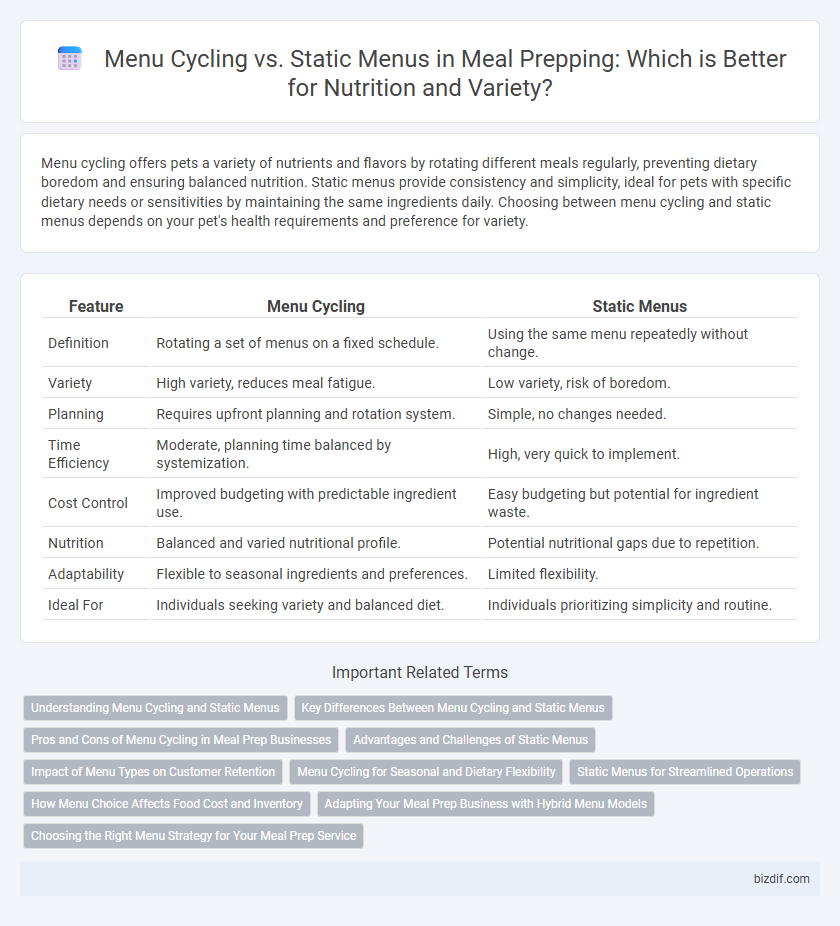Menu cycling offers pets a variety of nutrients and flavors by rotating different meals regularly, preventing dietary boredom and ensuring balanced nutrition. Static menus provide consistency and simplicity, ideal for pets with specific dietary needs or sensitivities by maintaining the same ingredients daily. Choosing between menu cycling and static menus depends on your pet's health requirements and preference for variety.
Table of Comparison
| Feature | Menu Cycling | Static Menus |
|---|---|---|
| Definition | Rotating a set of menus on a fixed schedule. | Using the same menu repeatedly without change. |
| Variety | High variety, reduces meal fatigue. | Low variety, risk of boredom. |
| Planning | Requires upfront planning and rotation system. | Simple, no changes needed. |
| Time Efficiency | Moderate, planning time balanced by systemization. | High, very quick to implement. |
| Cost Control | Improved budgeting with predictable ingredient use. | Easy budgeting but potential for ingredient waste. |
| Nutrition | Balanced and varied nutritional profile. | Potential nutritional gaps due to repetition. |
| Adaptability | Flexible to seasonal ingredients and preferences. | Limited flexibility. |
| Ideal For | Individuals seeking variety and balanced diet. | Individuals prioritizing simplicity and routine. |
Understanding Menu Cycling and Static Menus
Menu cycling involves rotating different meal options over set periods, enhancing dietary variety and preventing meal fatigue. Static menus offer consistent meal choices, simplifying preparation and streamlining ingredient management for efficient grocery shopping. Understanding these approaches helps optimize meal prepping strategies based on nutritional goals and time constraints.
Key Differences Between Menu Cycling and Static Menus
Menu cycling involves rotating a variety of meals over a set period, reducing repetition and ensuring nutritional diversity, while static menus offer a fixed selection of meals that remain constant. Menu cycling enhances meal planning flexibility and prevents taste fatigue by introducing seasonal ingredients or new recipes regularly. In contrast, static menus simplify procurement and preparation processes but may lead to monotony and nutritional imbalance due to limited variety.
Pros and Cons of Menu Cycling in Meal Prep Businesses
Menu cycling in meal prep businesses enhances variety and reduces ingredient waste by rotating dishes on a scheduled basis, keeping customers engaged and minimizing boredom. It requires meticulous planning and inventory management, which can increase operational complexity and costs compared to static menus. However, menu cycling allows flexibility to incorporate seasonal produce and adapt to customer preferences, ultimately boosting customer satisfaction and repeat business.
Advantages and Challenges of Static Menus
Static menus offer consistency and streamline meal prepping by allowing precise ingredient purchasing and reduced kitchen waste, making them ideal for budget-conscious planning. Their predictability supports time-saving meal assembly and helps individuals develop familiar eating routines. However, static menus can lead to dietary monotony and limited nutritional variety, which may decrease long-term meal satisfaction and adherence.
Impact of Menu Types on Customer Retention
Menu cycling boosts customer retention by offering variety that reduces meal fatigue and encourages repeat orders. Static menus can foster familiarity and streamline operations but risk monotony, leading to decreased customer engagement over time. Businesses balancing diverse, rotating options with consistent favorites often achieve stronger loyalty and sustained patronage.
Menu Cycling for Seasonal and Dietary Flexibility
Menu cycling enhances meal prepping by rotating dishes based on seasonal ingredients, ensuring fresher, more nutritious meals that align with dietary needs. This approach adapts to changing nutritional requirements and personal preferences, preventing menu fatigue and boosting adherence to healthy eating plans. Incorporating seasonal produce and varied recipes maximizes nutrient intake while maintaining culinary excitement and meal variety.
Static Menus for Streamlined Operations
Static menus enhance streamlined operations by reducing ingredient variability and simplifying inventory management, leading to consistent meal quality and faster preparation times. Meal prepping with static menus allows kitchen staff to master specific recipes, minimizing errors and waste while optimizing resource allocation. This consistency is crucial for businesses aiming to maintain efficiency and customer satisfaction in high-volume settings.
How Menu Choice Affects Food Cost and Inventory
Menu cycling reduces food cost by leveraging recurring ingredient use, leading to bulk purchasing and minimized waste. Static menus may result in higher inventory variability, increasing spoilage risk and fluctuating food expenses. Consistent menu rotation enhances supply chain efficiency and budget predictability in meal prepping.
Adapting Your Meal Prep Business with Hybrid Menu Models
Hybrid menu models combine the predictability of static menus with the variety of menu cycling, allowing meal prep businesses to adapt to customer preferences and seasonal ingredient availability effectively. Incorporating rotating dishes alongside consistent favorites enhances customer retention by balancing excitement and reliability in meal options. Leveraging data on popular meals and seasonal trends optimizes inventory management and reduces food waste, maximizing profitability in meal preparation operations.
Choosing the Right Menu Strategy for Your Meal Prep Service
Menu cycling enhances variety and customer satisfaction by rotating dishes regularly, reducing ingredient fatigue and streamlining inventory management. Static menus offer consistency and simplify operations by standardizing recipes and procurement, ideal for brands emphasizing signature meals. Selecting the appropriate strategy depends on your target audience's preferences, operational capacity, and goals for flexibility versus efficiency.
Menu cycling vs static menus Infographic

 bizdif.com
bizdif.com